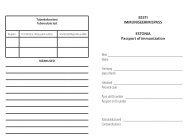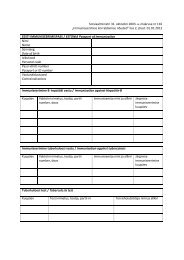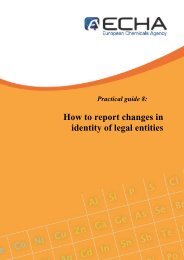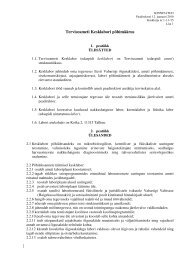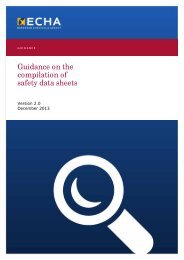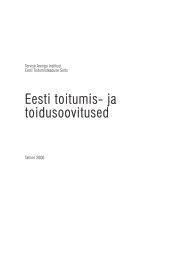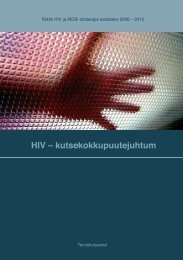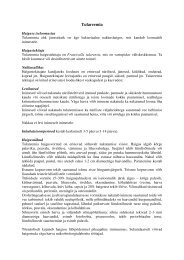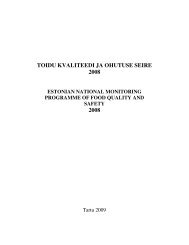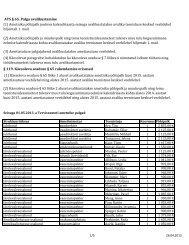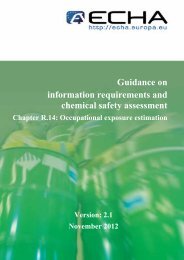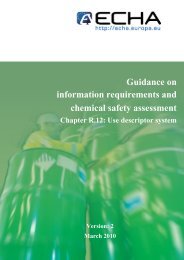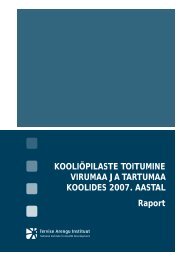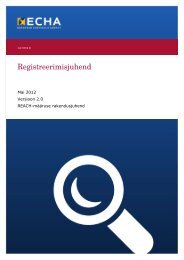Guidance for monomers and polymers - ECHA - Europa
Guidance for monomers and polymers - ECHA - Europa
Guidance for monomers and polymers - ECHA - Europa
You also want an ePaper? Increase the reach of your titles
YUMPU automatically turns print PDFs into web optimized ePapers that Google loves.
10<br />
<strong>Guidance</strong> <strong>for</strong> <strong>monomers</strong> <strong>and</strong> <strong>polymers</strong><br />
Version 2.0 April 2012<br />
<br />
<br />
<br />
A "monomer unit" means the reacted <strong>for</strong>m of a monomer substance in a polymer (<strong>for</strong><br />
the identification of the monomeric unit(s) in the chemical structure of the polymer the<br />
mechanism of polymer <strong>for</strong>mation may, <strong>for</strong> instance, be taken into consideration).<br />
A "sequence" is a continuous string of monomer units within the molecule that are<br />
covalently bonded to one another <strong>and</strong> are uninterrupted by units other than monomer<br />
units. This continuous string of monomer units can possibly follow any network within<br />
the polymer structure.<br />
"Other reactant" refers to a molecule that can be linked to one or more sequences of<br />
monomer units but which cannot be regarded as a monomer under the relevant<br />
reaction conditions used <strong>for</strong> the polymer <strong>for</strong>mation process.<br />
These definitions are exemplified in Example 2.<br />
A polymer, as any other substance defined in Article 3(1), can also contain additives<br />
necessary to preserve the stability of the polymer <strong>and</strong> impurities deriving from the<br />
manufacturing process. These stabilisers <strong>and</strong> impurities are considered to be part of the<br />
substance <strong>and</strong> do not have to be registered separately. Stabilisers include, <strong>for</strong> example, heat<br />
stabilisers, anti-oxidants (both useful during extrusion) <strong>and</strong> light stabilisers (e.g. <strong>for</strong><br />
preservation during use). Impurities are unintended constituents of the polymer such as<br />
catalysts residues. The quantities of a monomer substance which do not react during the<br />
polymerisation reaction <strong>and</strong> remain in the composition of a polymer are referred to as<br />
“unreacted <strong>monomers</strong>”. Unreacted <strong>monomers</strong> in a polymer are also constituents of that<br />
polymer. Registration obligations linked to the presence of these unreacted <strong>for</strong>ms are<br />
explained in sections 3.2.1 <strong>and</strong> 4.2.2 3 .<br />
Substances may also be added to improve the per<strong>for</strong>mance of the polymer even though they<br />
are not necessary <strong>for</strong> preserving the stability of the polymer. Indeed, substances are<br />
commonly added to a polymer <strong>for</strong> the purpose of adjusting or improving the appearance<br />
<strong>and</strong>/or the physico-chemical properties of the polymeric material. Examples of such substances<br />
include pigments, lubricants, thickeners, antistatic agents, antifogging agents, nucleating<br />
agents <strong>and</strong> flame retardants. When a polymeric material contains such substances it should be<br />
considered as a mixture or an article, as the case may be (see section 3.3). For such<br />
substances normal registration requirements apply (see the <strong>Guidance</strong> on registration)<br />
Under REACH <strong>and</strong> in the guidance documents developed by the Commission <strong>and</strong> <strong>ECHA</strong>, only<br />
stabilising agents are considered as additives. Substances added to <strong>polymers</strong> to provide any<br />
function other than stabilisation are commonly called “polymer additives”. However, <strong>for</strong> the<br />
purpose of this guidance, these substances are not referred to as additives.<br />
When a given substance can be used both <strong>for</strong> preserving the stability of the polymer <strong>and</strong> <strong>for</strong><br />
improving its per<strong>for</strong>mance (e.g. if the substance acts as a light stabiliser <strong>and</strong> a flame<br />
retardant), it is good practice to consider only the quantities necessary to preserve the stability<br />
of the polymer substance. The quantity of the substance that is not necessary to preserve the<br />
stability of the polymer cannot be regarded a part of the polymeric substance. It should be<br />
considered as another substance within a mixture. As such it may need to be registered.<br />
3 The approach suggested with regard to reacted <strong>and</strong> unreacted <strong>monomers</strong> <strong>and</strong> other substances follows the judgement<br />
of the European Court of Justice in EU Case C-558/07 of 07 July 2009 available at http://eurlex.europa.eu/LexUriServ/LexUriServ.do?uri=CELEX:62007CJ0558:EN:HTML.<br />
See in particular paragraphs 20,<br />
38 <strong>and</strong> 51 of the judgment.<br />
Annankatu 18, P.O. Box 400, FI-00121 Helsinki, Finl<strong>and</strong> | Tel. +358 9 686180 | Fax +358 9 68618210 | echa.europa.eu



